Creating Substances of a Higher Order – Spagyrics and Synergy
By Dennis Klocek 22 min read
The naturalist D’Arcy Wentworth Thompson, who wrote the classic book On Growth And Form, believed that the outer form of an organism is a diagram of the forces that are active within the organism. He took this idea further by stating that germ plasm is always the seat of forces and never the source of forces.
A century earlier the poet Goethe would consider that all life processes were the result of an energetic or morphological form principle that is the source of the formative processes that generate the organism. In his extensive and disciplined research into natural science, Goethe came to call these archetypal formative principles “be-comings”. He felt that the formative or ontological be-comings of an organism could be perceived in its outward form or appearance.
Two hundred years before Goethe the great alchemist and physician Paracelsus coined the word spagyric to describe his attempts at capturing the formative life principles of substances within healing medicaments. In the language of Paracelsus spagyric means to take apart and put together again. What Paracelsus was taking apart he called the archeus or iliaster (star body) of an organism. This iliaster or archeus of Paracelsus was the equivalent of Goethe’s archetype. The unmanifest archetype guided the manifest organism into a “becoming” sequence of events on the way to manifestation.
The Holy Grail of alchemical work was to take apart the manifest form, purify the separate parts and then marry the separated parts back together again to form a spagyric substance.
PARACELSUS AND THE THREE UNIVERSAL PROCESSES
In the spagyric method, alchemists were required to first identify the path of development that a life form underwent in its ontogeny in order to precisely dismantle the life form into its separate life principles. The separation had to be achieved while maintaining the proper relationships of parts in order to keep the wholeness of the archetypal “form” intact.
During the time of Paracelsus, it was understood that the forces of life were organized into universal states known as sal, sulf and merc. These three universal life principles were seen in the world as: the precipitating or crystallizing forces present in salt falling out of a solution(sal), the volatilizing and rarifying metabolic force of oil production and combustion in sulfur processes (sulf), and the rhythmic forming and dissolving patterns inherent in the oscillation of sal and sulf (merc). The rhythmic, mercurial oscillations are the energetic core of the transformative processes that underpin the evolution of organic forms. To the imagination of the day, this fluid, magical core of the process of transformation bore the signature of the metal quicksilver, also known as mercury (merc).
SPAGYRIC LEMON BALM ESSENCE
It was considered essential in the processing of a spagyric sequence that the sal, sulf and merc of the life form be separated, purified separately, and then reunited or married into a higher order.
A simple protocol for making a spagyric essence of the herb lemon balm (Melissa officinalis) can serve as an illustration.
In the living tissues of the lemon balm the essential oil (sulf) and the plant salts from the soil solution (sal) are bound together in such a way that separating them for the purpose of purification and intensification takes considerable effort. Simply making a tea of lemon balm volatilizes some of the oils into the water along with a few salts but does nothing to purify and enhance their forces as substances, to say nothing of putting them back together again.
In spagyrics, the steam distillation of the oil from the plant is the first step. This draws the oil out and allows it to be concentrated into a more potent form than is found in the plant itself.
As a second step, the steamed plant material is subjected to an extractive (merc) fermenting process focused on breaking down the plant material even further than the steaming. In past practice, this extraction was achieved by fermenting the steamed plant material and dissolving it in the resulting alcohol solution. The alchemists would then gather the alcohol of the plant as a universal or mercurial solvent. Alcohol was considered mercurial because plant alcohols are ubiquitous substances in plant chemistry that serve the plant by forming the substrates of most living substances. All plants produce alcohol when fermented. This was seen as mercury.
After the alcohol was taken off, the dregs of the fermenting barrel would then be so open and dissolved that the salts that originally drove the life forces of the plant could be more effectively subjected to a burning and subsequent ash extraction process. The dregs would be repeatedly burned until they were reduced to a fine white ash. The ash was then slowly dissolved in soft water until the water took up the soluble salts. The salt solution was then evaporated to reveal the pure mineral salts present in the living plant.
The separated essential oil, alcohol, and purified plant salts would then rhythmically be introduced into each other in what the alchemists called the marriage or wedding. The resulting spagyric substance was composed of the original oil, alcohols, and salts of the living plant but they had been separated, purified and then married back together in order that the resulting substance would have what today would be called a synergistic relationship. The key to this process was to maintain the form principle or “becoming” of the original plant so the resulting marriage could result in synergy and medicinal potency.
RUDOLF STEINER, BIODYNAMICS AND ALCHEMICAL WISDOM
In his work with a renewal of agricultural practices, Rudolf Steiner outlined an alchemically inspired methodology for making preparations that bring enhanced forces to the growth of plants.
These Biodynamic preparations take the principle of the spagyric process to another level of potency while still maintaining the fundamental requirements of (1) realizing the diagram of forces that is present in the substances as a path of becoming, and then (2) uniting the different substances in an alchemical marriage.
The first requirement is accomplished by close observation of the growth and development patterns of minerals, plants, and animal organs that serve as energetic “sheaths” for the incubation of synergistic relationships.
Since an organ is not the source of energies but is receiving energies from its environment, the organ itself is a kind of antenna designed to receive specific qualities of life forces. In antenna theory, the antenna and the signal need to be a picture of each other. A particular sheath is chosen for a preparation that will draw in particular forces from its environment.
When the substance in the sheath and the sheath itself are in alignment there is an amplification of the signal or formative pattern of becoming. The signal in this case is the archetypal “becoming” of the spiritual form pattern that gives rise both to the substance in the sheath and the sheath itself.
BD PREPARATION 501 EXAMPLE
In Biodynamic practice, a sheath-like cow horn has a form that is capable of amplifying the archetypal patterns of whatever is placed inside it.
The formation or becoming of the cow horn is a repeated mercury process of the laying down of fine protein layers of keratin. This is a formative process in an animal that is similar to the formative processes of layered siliceous materials such as muscovite mica. As a result of this layering in its becoming gesture as a mineral, muscovite mica is used as a capacitor in electrical circuits. The capacitor’s function is to receive weak impulses and concentrate them into higher field potentials for the electric field. The mica does this because of its multiple inner layering formative process that traps weak voltages and forms them into a field of potentially stronger voltages. This inner layering process of “becoming” is what mica, as a silicate, has in common with quartz. A cow horn shares this ontological layering gesture of becoming with the silicates. In effect, this layering gesture of becoming gives the cow horn the function of a natural capacitor.
We could say, without exaggeration, that in the BD preparation 501 a cow horn filled with powdered silica is what antenna engineers could call an oscillating capacitance circuit. The different charge potentials between the keratin and the silica have the potential for oscillation and the creation of field potentials in the silica. The tapered form of the horn is a natural amplification device for sound and in the cow can theoretically serve to amplify weak input forces of sunlight and warmth into the body of the cow.
In this spagyric form of thinking the molecular structure of the silica and the molecular structure of the keratin are seen as similar in their spiral arrangement even though the substances are not the same. This is a spagyric principle of becoming in that the horn and the mineral have similar becoming processes of the sal formative process (deposition).
The horn and the silica have a similar sulf process (metabolic potential for transformation) seen in the linkages of the keratin as a broad-based metabolic product of the protein production of the cow, and the sulf gesture of the quartz as the most fundamental mineral formation in nature. The widespread dissolving of silica through weathering leads to the myriad forms of many minerals and gems. Weathering is the sulf of silica.
In the mercury process of this preparation, the repetition of countless spiral molecules of keratin into long protein chains and the countless molecular formations of tetrahedral spiral strands in the quartz crystal are a shared mercury gesture (repetition of simple patterns resulting in gradual enhancement of the whole is merc).
It should be noted that in Biodynamic preparations the sal, sulf and merc principles are not restricted to the breakdown and buildup of a single organic entity, the examples of the formative force motifs are sought in different kingdoms. This differs from traditional spagyrics but has the advantage that when married alchemically, the similar gestures of becoming found in different levels of the natural order can unite in a higher synergy of force.
In summary then, the spagyric principles of the Biodynamic method take the older methods of Paracelsus and expand them to the ontological and morphological gestures of becoming between entities in different kingdoms of mineral, plant, animal and even in the consciousness of the human being who guides the protocols. This last level is the creative level of preparation making that lies in the future research process in Biodynamic agriculture.
ROSE QUARTZ AND HELICHRYSUM PREPARATION
To illustrate how these higher spagyric methods can be used to develop other substances than those inherited from Rudolf Steiner, the experimental union of rose quartz and the herb helichrysum italicum can serve as an example.
In the following examples, the sal, sulf and mercury levels of these entities will be used to show the higher spagyric links based on the principles found in Steiner’s Agriculture course.
ROSE QUARTZ “BECOMING”
As a silicate mineral, rose quartz differs significantly from other members of that family in the manner in which it precipitates into a sal condition.
Several variables need to be met before the gem manifests. A very high temperature (1328 F) gives rise to a gaseous or vaporous state in the magma. The presence of 10% boron in the magma along with iron creates the conditions for precipitation of the quartz directly out of the gaseous state.
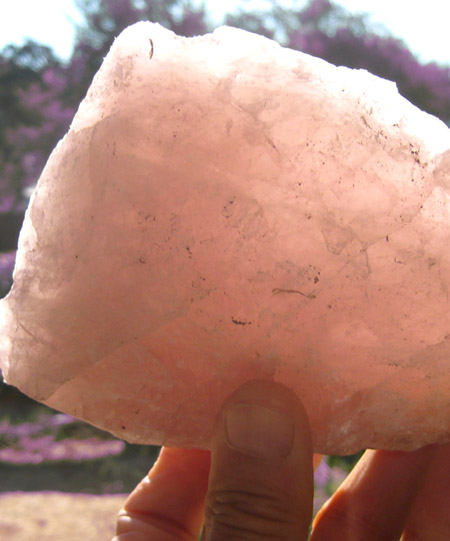
These conditions result in the submicroscopic formation of nano-sized needles that form the seeds of the crystal matrix of rose quartz. The nano-sized crystal needles are arranged in a true X, Y, and Z planes of space configuration. That means that even at that small size (1/1000 of the width of a human hair) the crystal matrix is oriented to the standard spaceplanes of quartz. However, the nanocrystals do not link up in a typical silicate fashion. They each maintain integrity as a submicroscopic needle array without connecting to the others. This is unusual for silicates. Even more remarkable, even though the individual crystals are not connected they all have a common orientation to the three planes in space. They are all linked in spatial planes but remain separate as individual nano-sized crystal forms. The formation of the cloud-like structure of the gem is a sulf gesture in that the crystal is actually composed of flowing independent structures. It is in reality a cloud of mineral vapor solidified.
In the activity of rose quartz, the becoming gesture of the gem as it cools from a vapor in the earth is initiated by the minute needle formations. These are induced into form as iron interacts with boron. When this happens the contraction of the vapor exudes minute fibers composed of the needle structures. These mineral fibers give the gem its amorphous crystalline quality. They gather light within the rock mass to the degree that in conditions of ambient light such as a cloudy day a piece of rose quartz in your hand appears to be glowing with a light issuing from the inside of the stone. The countless minute inner crystals are all diffusing the light.
HELICHRYSUM “BECOMING”
Smallness is also part of the “becoming” of the helichrysum, the seed of which appears to be as fine as dust and must be gently pressed into the surface of the soil with no soil covering it. The seeds laying on the surface must be moistened every day but must not sit in water. A long germination phase of about a month is finally completed when seedlings the size of a pinhead emerge from the seed.
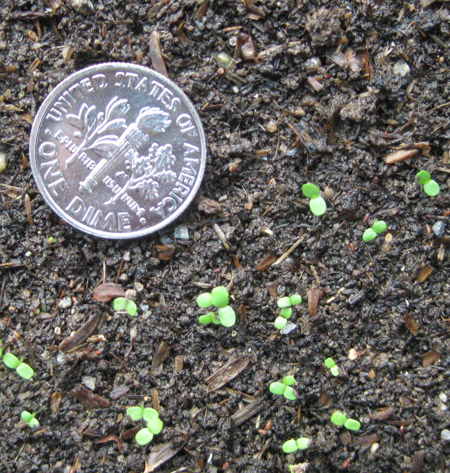
We could say that the sal gesture of coming into being for both the mineral and the plant have similar characteristics as what Rudolf Steiner called the action of the smallest entities. The gesture of smallness and delicate inner structures in rose quartz, is also present in the flowering process of helichrysum italicum. It is a member of the aster family and bears clusters of small spherical flower buds that open into tiny florets that require a lens to observe well. The flowers are about the size of a lentil when fully opened and are arranged in clusters that hang on long attenuated stalks. In several botanical sources, the inflorescences hovering above the plant bodies are described as cloud-like.
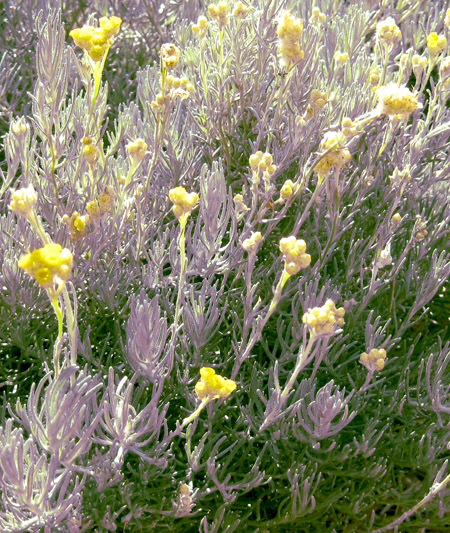
The essential oil content of a plant is the sulf component of plant growth. The essential oils of this plant are so rarefied in a classic sulf gesture, that it takes a 2,000 lbs of flowers to make one and a half quarts of essential oil. As a result, the experimental protocol for this spagyric substance features helichrysum hydrosol and not the essential oil.
In a hydrosol, minute particles of oil are solved within the water and never separate out due to their extremely small size. A hydrosol is a cloud of essential oil in water.
In its mercury gesture, the oil composition of helichrysum is remarkably variable depending upon the length of the day, available warmth, soil moisture, soil texture, harvest timing and soil profile. Even though all plants in the species are similar in genetic structure the analysis of the oils produced on two neighboring plots can be remarkably different. One oil composition will be effective for cutaneous scar healing and the oil from a neighboring area will have a composition most useful for muscle aches or nerve issues. This remarkable flexibility of the plant to meet stress by creating different combinations of essential oil fractions is why helichrysum is thought to be one of the most valuable healing oils.
SUMMARY OF SAL AND SULF
In summary, both the helichrysum and the rose quartz have a life gesture of being highly active in the smallest parts. They also possess similar life gestures of sal and sulf. However, it is in the realm of mercury that the true power of the combination can be seen.
MERCURY INFLUENCES
The mercury influence is carried by the repetition of parts that creates a gradual enhancement. Goethe called it polarity with enhancement of the archetype. Paracelsus called it archeus or iliaster. It could also be called the morphogenetic field to use the term coined by Rupert Sheldrake.
These descriptions and many others have been used since early times to characterize the action of the invisible on the emergence of the visible. Ernst Haeckel called this mysterious force phylogeny. The generation of the one out of a field of activity of the many. Darwin called this influence the common ancestry of species.
Whatever you call it, these minds were all describing the path of emergence from non-being into being. This is a path taken by all organisms. These researchers all understood that the changes incurred as a young entity moves through life have common threads whether that entity is a plant, an animal, or a human. Current science can even allow us to include minerals and weather systems in this attempt at creating a language of “becomings” that can help human beings understand the complexities of the web of life. The most potent aspect of these morphological changes is the oscillation of polar states of existence such as sleep and wakefulness, health and illness, growth and form. The movement between these polarities was known to the alchemists as the mysterious healing mercury.
BORON AS MERC
In rose quartz, the boron that instigates the unique crystalline features is, in the economy of nature, also the most important trace mineral for the proper growth of plants. This is because at the level of a few hundred parts per million boron has a profound influence on the growth of new cells in the meristematic tissue that is the site of growth in all plants.
Without available boron, the meristem ceases to grow and the vegetative propagation that is the hallmark of green plants comes to a halt. This causes leaves to wither. Without a supply of boron fruits to fall off without being set. This is because pollen tubes depend on a constant source of boron to migrate through the tissues of the pistils of plants in their ardent journey towards the embryos. Without boron, the meristem ceases to proliferate new cells in a regular fashion.
Mercury is the alternation of cell proliferation rhythmically coupled to orderly cell division. This relationship, instigated by boron, is the most fundamental synergy of the mercury forces between the mineral and plant kingdoms. Official government sources cite that the lack of available boron for plant development is the most critical cause of hunger in the third world through crop failure.
HELICHRYSUM AS MERC IN ANIMAL CELL DIVISION
As a plant acting in the animal world helichrysum italicum, through the intensity of its essential oil chemistry, is widely known to accomplish the orderly proliferation of cells and the regeneration of scar tissue, nerve regeneration, dissolution and restructuring of blood clots, and the regulation and tone maintenance of tissues of the circulatory system.
Helichrysum brings animal systems that are in chaos back into order by stimulating cell proliferation while at the same time regulating the archetypal patterning of the cells into the tissue requirements of the site of the damaged tissue. This is the mercury gesture of helichrysum italicum in the plant/animal interface that is remarkably similar to that of rose quartz in the mineral/ plant interface.
So now we have similarities in the sal, sulf and merc gestures of helichrysum italicum and rose quartz. How can we amplify the spagyric principle to get them to marry?
THE ALCHEMICAL WEDDING
The spagyric rule is first to separate, then purify, then unite again in a rhythmic interplay to create a marriage. How can we take advantage of the action of smallest entities in this marriage?
The chemist Johannes Van Helmont made the discovery that alkalis dissolve silicates. This was following in the footsteps of the alchemist Basil Valentine who legend tells us discovered water glass or sodium silicate by dissolving sand in alkaline solutions. This process points to a method where the rose quartz can serve as a mineral mercury that brings together the sal of the helichrysum and the sulf of the helichrysum. The sal of the helichrysum is the alkali salts and the sulf of the helichrysum is the hydrosol containing the minute particles of essential oil.
NANO ROSE QUARTZ
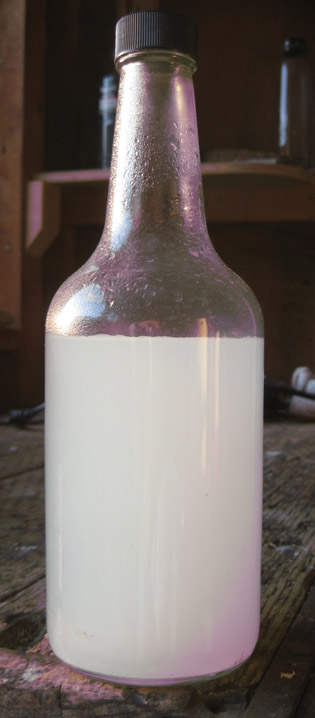
The preparation of the mineral mercury differs from the alcoholic mercury of the past. Following Steiner’s lead in the BD preparations, the method for unfolding the dynamic mercury nature of rose quartz is to render the gem into as fine a particle size as is practical and then incubate it in an animal sheath in a compost heap.
The fine particle size is achieved by grinding the rose quartz in a gem tumbler. Several grades of crushed rose quartz are used without the typical carborundum, alumina, or garnet abrasives.
The quartz is a seven on the Moh’s scale and can act as its own abrasive if the sizes of the particles are graded in a way similar to that found in nature as rocks are tumbled in streams. Sand-like grit up to quarter-inch pebbles or flakes are the fines. Next come the half-inch flakes grading up to one and a half-inch cubes or chunks. The final grade is two or three large rocks of rose quartz. This makes up the grinding medium.
The mix is put in the tumbler with water and tumbled for two days until a fine milk-like liquid is present. This is strained off and more water is added until a few quarts of the rock milk is gathered.
ROCK MILK AND PERICARDIUM
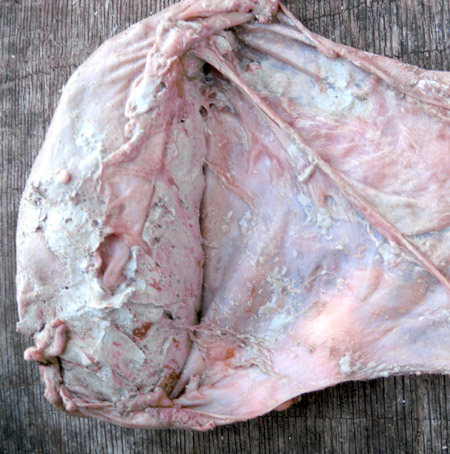
The rock milk is then mixed with a small amount of either sodium silicate or soda ash or, if available, a traditional solution made from the ashes of burnt kelp.
These substances flocculate the liquid and cause the coarser parts to settle out with a very fine rock milk left as a colloid. The colloid particles will stay suspended indefinitely when treated this way.
The colloidal liquid is then evaporated into a very stiff, unworkable paste. To help with the workability a small amount of rye flour is added to make a rock dough.
The rock dough is then sewn into the pericardium of a cow. In the image above the paste is included in the membrane.
The pericardium is the sheath of tough membranous material that surrounds the heart. It is the first organ to form in an embryo. It’s “becoming” is remarkable in that it forms outside of the head and travels through the mouth of the embryo downward through the embryo towards the blood that is rising from the yolk sac below. This “be-coming” gesture of the pericardium illustrates its action as a bridge between the periphery and the center in the organism. We use it as a sheath for the rose quartz to amplify the generative reciprocal forces of the meristem and cellular division in general.
Past experiences with gems powders placed in pericardium tissue revealed a curious phenomenon that insects were strongly attracted to create nurseries for their eggs in the minerals surrounded by the pericardium. Beetles found the mineral/peridium/cow horn trio deep within the compost heap and when it was exhumed the mineral paste was riddled with the eggs and larvae of a small beetle.
The mineral was washed free of the eggs and larvae, dried, lightly pulverized and placed in a ceramic container with a loose-fitting lid on the top shelf in a storage shed. Months later a stream of ants coming up through a crack in the concrete pad had found its way into the shed, up the leg of the shelf, and into the ceramic container. Upon opening it the ants had filled the mineral with brood.
After these experiences pericardium was deemed worthy of research as a sheath for mineral preparations.
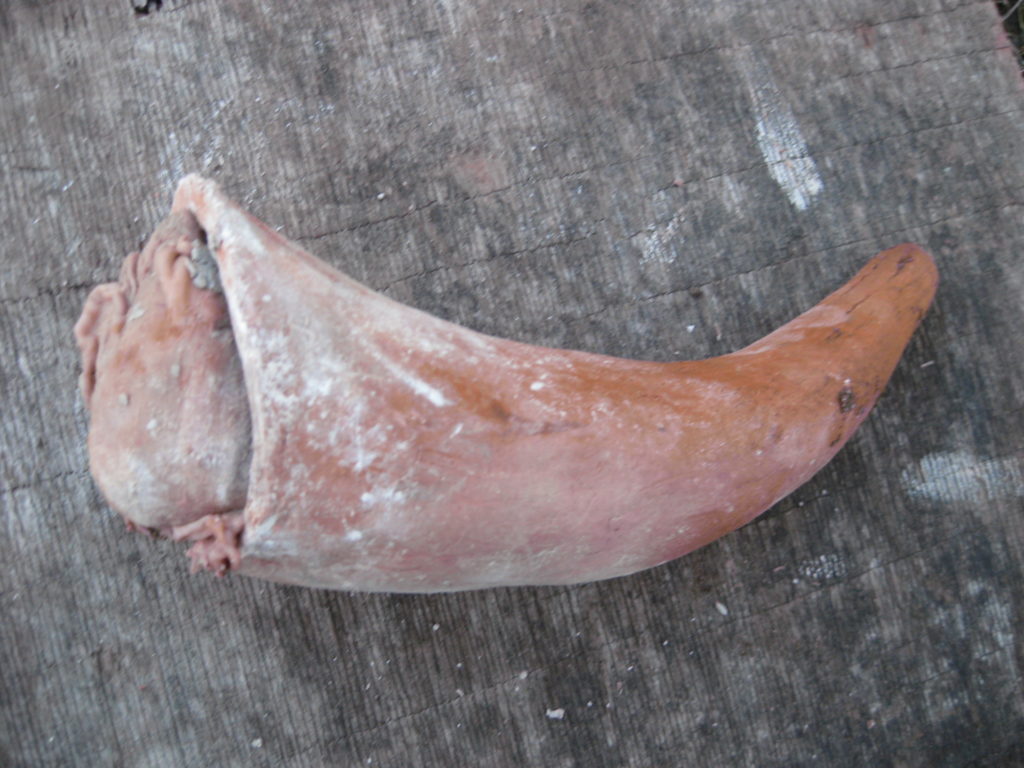
CLAY HORNS AND A COMPOST PLACENTA
In the silica and manure preparations in Biodynamics, cow horns are used for the incubation process.
It is felt that this preparation of fine rose quartz needs a more porous sheath so we are following the line of research of Biodynamic farmers in India who use clay horns instead of the hard-to-acquire cow horns.
Clay horns are cast and fired to a low bisque temperature that gives the form of the horn to the rose quartz prep, but the porous clay allows for enzymatic interaction with a “placenta” that the clay horn is placed in for the incubation.
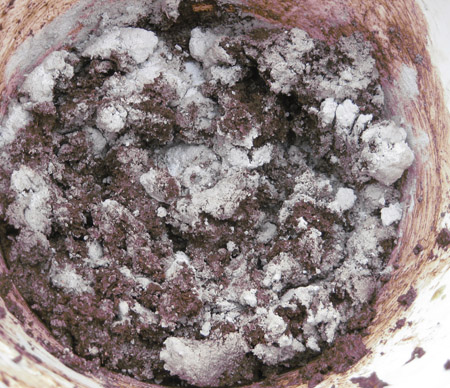
The formation of a special compost placenta is taken from indications of Paracelsus in his descriptions of the “embryonates” present in the formations of metallic ores. In this case, a special compost was made using green fresh clover, horse manure, birch leaves, powdered rose quartz, an ultra-fine solution of a clay mixture known to potters as terra sigillata (formed using the sodium silicate flocculation process), and fresh, pulverized flowering tops of helichrysum italicum. The plant materials are run over with a lawnmower to pulverize them and the other materials are added to make a moist cake-like compost.
The clay horn containing the pericardium/rose quartz “burrito” is placed in the center of a porous clay vessel filled with the special compost. The vessel is then placed in an active compost heap to ferment for several months. When finished the fine rose quartz powder of the clay horn is placed in a solution of alkaline salts of helichrysum italicum and circulated in a Mary’s Bath (see “Mary’s Bath” below).
PREPARING THE ALKALINE SALTS
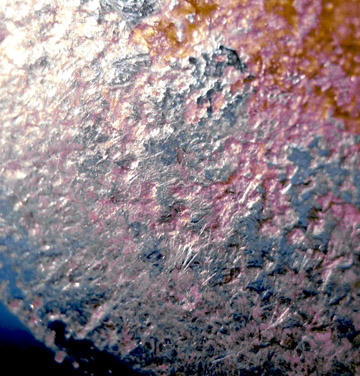
Working with the herb, the first step is to distill out the hydrosol of the flowering tops of helichrysum. This liquid tests acid with litmus paper. The acidic oil-rich hydrosol solution of sub-microscopic droplets of oil in water is the sulfur of the helichrysum.
The plant material that comes out of the still is then dried and rhythmically calcined many times until it is reduced to a white ash. The ash contains the alkali salts of the herb. Rain water is used in a flask over a gentle heat to extract the saline constituents from the plant ash. The salt solution is reduced through evaporation until crystals begin to form out of the liquid. This liquid tests very alkaline with litmus paper. This solution is the sal.
With these processes, we have separated the sal and the sulf of the herb and now can place what comes out of the fermenting pericardium “burrito” into the sal solution.
MARY’S BATH
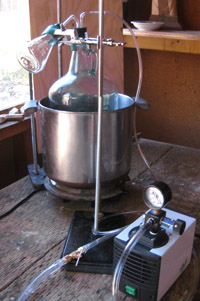
Using Van Helmont’s discovery that highly alkaline substances dissolve silica, the sal solution is added to the colloidal solution of the finest particles of the ground rose quartz.
The herbal alkali (sal) and the colloidal rose quartz are then submitted to a process of circulation in a water bath known to alchemists as Mary’s Bath (bain marie). This provides gentle heat during the day and a cooling period in the evening. A slight vacuum is drawn by the pump and stopcock to enhance the circulation process of the silica and the alkali salts. Much space in the top of the gallon jug allows for expansion of the vapors to “loosen” the substance’s resistance to the marriage.
After twenty days of circulation, helichrysum hydrosol is added to this mixture and circulated again. The addition of an acidic hydrosol to the alkali salt solution once again revives the silica and neutralizes the alkalis to form a neutral solution of helichrysum/rose quartz.
This solution is applied as a fine mist spray over the plants in the evening by the rate of one tablespoon per liter of water. Sprayings took place for the three days on either side of a moon that was changing phase (dark, 1st quarter, full, 3rd quarter). This was continued for a month and a half and then discontinued to see if there was an influence on the early development of seedlings.
RESULTS
Early results show that sprayed seedlings of garden vegetables seem to benefit in their early growth from the spray as opposed to controls. Stronger horizontal or vegetative forces are evident in the sprayed crops. This vegetative vigor is carried over into maturity in most of the vegetables. Highly sulfurous vegetables like leeks showed little early influence.
The following photos show some results from seed started in the summer of 2013.
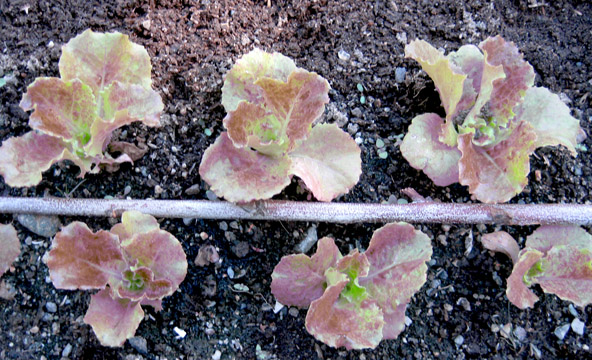
Lettuce seedlings in a flat before transplanting. Sprayed lettuces are at the top. Unsprayed lettuces from the same seed in the same flat are at the bottom.
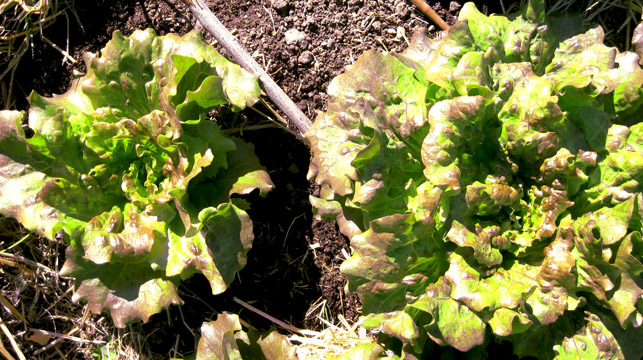
Mature lettuces- these lettuces are side by side in a garden bed with the same soil preparations. Sprayed lettuce is on the right with control/unsprayed on the left.
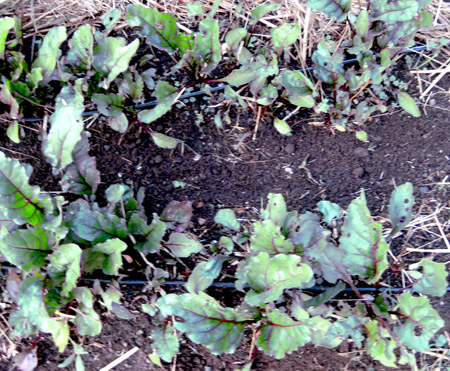
Beet test: the two rows of beets are side by side in one bed with the same soil preparation. They were sown on the same day. The row at the bottom is the sprayed row and the row at the top is control.
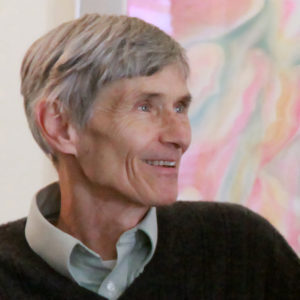
Dennis Klocek
Dennis Klocek, MFA, is co-founder of the Coros Institute, an internationally renowned lecturer, and teacher. He is the author of nine books, including the newly released Colors of the Soul; Esoteric Physiology and also Sacred Agriculture: The Alchemy of Biodynamics. He regularly shares his alchemical, spiritual, and scientific insights at soilsoulandspirit.com.
Similar Writings
In the Lab: Using a Simple Still for Home Extraction of Essential Oils
Join Dennis, an experienced gardener with 50 years of expertise, as he walks you through the detailed process of distilling essential oils from medicinal plants, specifically lemon balm. Learn how to use an old pressure cooker as a functional still, the importance of proper herb preparation, and the step-by-step distillation process using various laboratory glassware…
Considering Helichrysum
In science today the driving force is to solve mysteries by innovation. Innovation is the clever manipulation of what is already known. As an effective research method for solving technical problems innovation has created wonders. But life evades technical solutions. Uncontrolled pandemics and complex climate change issues result from technical innovation being applied to issues…